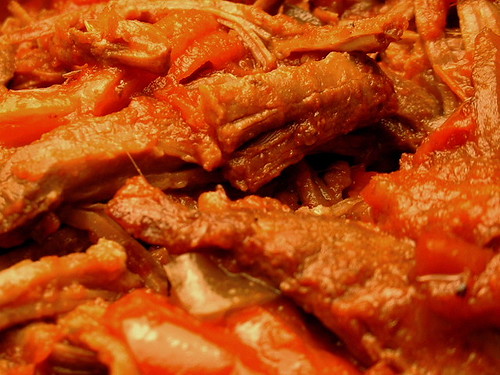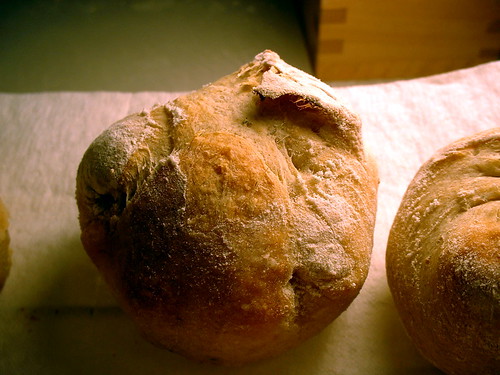Sara Moulton has a pretty good recipe for it in Sara's Secrets for Weeknight Meals. It's a "quicker" version, taking 3 hours from start to finish (and for this dish, yes, 3 hours is quick). Theoretically, you could get home at 5:30, start cooking, and have a late dinner around 8:30. My only complaint is that Sara Moulton's recipe calls for olives and some of the olive jar liquid, and all I could taste in the finished dish was OLIVE (and I LIKE olives, folks). Cut back on the olive flavor... it's a winner. Her recipe does a really nice job of making this time-consuming dish into something that someone COULD make during the week after work.
On the other hand, there's Daniel Boulud's recipe in Braise, which I made on Monday night/Tuesday morning. This cookbook is exactly what the title suggests: nothing but slow-cooked, braised dishes. His ropa vieja recipe calls for the meat to marinate overnight in a garlic and oregano rub, and then cook for 4 hours the next day. I ended up futzing with the schedule for it a bit. The meat marinated while I was at work Monday, and instead of cooking it for 4 hours in a 275-degree oven, I cooked it overnight in a 200-degree oven (which, yes, meant that I was getting up every couple of hours to flip the meat and make sure I hadn't accidentally lit the kitchen on fire). The meat fell apart as soon as I touched it Tuesday morning, and the sauce flavor is deep and rich. It's filling and satisfying without being heavy. I had white rice with mine, mixing the shredded beef and vegetables in with the rice.

Ropa Vieja (the extra-long version)
serves 4
3 garlic cloves, chopped
1 teaspoon dried oregano
1 teaspoon kosher salt
1 lb flank steak
1-2 tablespoons extra-virgin olive oil
1 medium onion, thinly sliced
1 green bell pepper, cored, seeded, and thinly sliced
1 red bell pepper, cored, seeded, and thinly sliced
1/2 cup sherry
1 14.5 oz can crushed tomatoes (low sodium or no salt added, if possible)
2 bay leaves
Fresh ground black pepper
Combine the garlic, oregano, and salt. Place the meat in a nonreactive container and rub on both sides with the garlic mixture. Cover with plastic wrap and refrigerate for 6 hours to overnight.
Place a rack in the center of the oven and preheat to 200 degrees F.
Heat 1 tablespoon of olive oil in a large ovensafe pot or Dutch oven over high heat. Scrape the rub off the meat and reserve. Sear the meat on both sides until browned, 5-7 minutes. Transfer the meat to a plate and set aside.
Add another tablespoon of oil to the pot if needed. Add the onions to the pot and cook until light brown, 8-10 minutes. Add the bell peppers and cook for 5 minutes. Add the sherry (away from the heat!), bring to a simmer, and scrape any browned bits from the bottom of the pot. Add the tomatoes, 1 cup of water, the reserved rub, and the cayenne pepper. Return the meat to the pot, nestling it in with the vegetables. Add the bay leaves and salt and pepper to taste. Bring to a simmer.
Cover the pot and transfer it to the oven. Cook until the meat is tender, 6-8 hours, turning the meat every 1.5-2 hours. (If the liquid level gets too low, add more water; the sauce should be thick, but not a paste.)
Remove the bay leaves from the pot, shred the meat, and serve.



